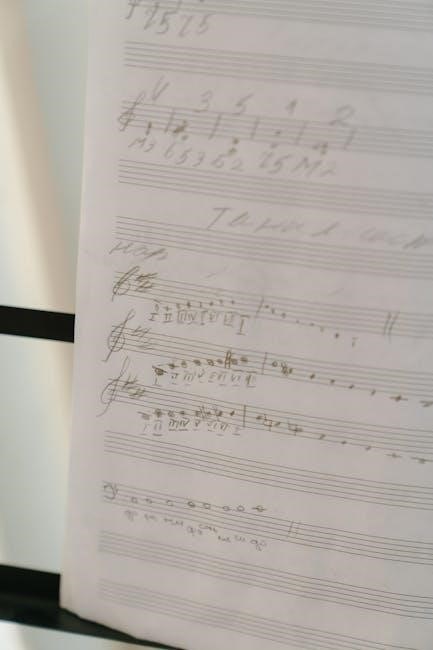Fur Elise is a beloved piano piece, especially for beginners. Sheet music with letters provides an accessible way to learn, combining traditional notes with easy-to-read letter labels for better understanding and practice.
1.1 Importance of Sheet Music with Letters for Beginners
Sheet music with letters is a vital tool for beginners, as it simplifies learning by combining traditional notes with letter names. This approach helps in identifying notes effortlessly, especially for those unfamiliar with musical notation. It overcomes the initial hurdle of reading sheet music, allowing learners to focus on rhythm and technique. The inclusion of letters builds confidence and accelerates the learning process, making it an ideal resource for mastering pieces like Fur Elise. This method ensures a smooth transition from basics to more complex skills.
1.2 Brief Overview of Beethoven’s Fur Elise
Fur Elise, also known as Bagatelle No. 25 in A minor, is one of Beethoven’s most recognizable compositions. Written in 1810, it was not published until after his death. The piece begins with a famous, haunting melody that has become iconic in popular culture. Its complex structure and emotional depth make it a challenging yet rewarding piece for pianists. For beginners, simplified versions with sheet music featuring letters alongside notes provide an accessible introduction to this timeless masterpiece, helping to bridge the gap between simplicity and Beethoven’s original brilliance.

Structure of Fur Elise for Beginner Sheet Music
The beginner-friendly arrangement simplifies the original piece, combining traditional notes with letter labels for easy recognition. The melody is broken into manageable sections, ensuring a smooth learning process.
2.1 Simplified Version of the Original Composition
The simplified version of Fur Elise is designed for beginners, offering an easy-to-follow arrangement of Beethoven’s classic piece. It retains the iconic melody but adjusts the tempo and complexity to suit learners. The sheet music features letter labels on notes, making it easier for those unfamiliar with traditional notation. This adaptation ensures that the essence of the original composition is preserved while being accessible to new pianists. The PDF format allows for clear readability, with notes named to guide practice effectively.
2.2 Breaking Down the Melody into Sections
The simplified sheet music divides Fur Elise into clear sections, allowing beginners to focus on one part at a time. Each section highlights the melody with letter labels, making it easier to follow. This step-by-step approach helps learners understand the structure and flow of the piece. By breaking down the composition, beginners can practice individual segments before combining them, ensuring a smooth and confident performance. This method aids in mastering the piece gradually and effectively.
Benefits of Using Sheet Music with Letters
Sheet music with letters enhances readability for beginners, simplifying note identification. It combines traditional notation with letter names, making it easier to learn and practice. This approach boosts confidence, allowing learners to focus on technique and musicality, ultimately aiding in mastering Fur Elise effectively.
3.1 Note Names for Easy Identification
Sheet music with note names simplifies learning for beginners. Each note is labeled with its corresponding letter, making it easier to identify pitches. This method ensures that learners can focus on playing without confusion. The combination of letters and traditional notes aids in understanding musical notation. Over time, this approach helps build familiarity with note names, enhancing overall musicianship. It’s particularly useful for those new to reading sheet music, as it bridges the gap between letters and notes seamlessly.
3.2 Combining Letters and Notes for Better Understanding
Combining letters with traditional notes offers a clear guide for beginners. This dual approach allows learners to associate each letter with its corresponding note, enhancing recognition and memory. The integration of both systems ensures that the melody and rhythm are easily grasped, making practice more effective. This method is especially beneficial for those who struggle with reading sheet music, as it provides a visual aid that accelerates the learning process and builds confidence in playing complex pieces like Fur Elise.
Tutorial for Practicing Fur Elise
A step-by-step guide helps beginners master Fur Elise. Start with the melody, then gradually incorporate harmony and rhythm. Practical tips ensure smooth progress and confident performance.
4.1 Step-by-Step Guide for Beginners
Begin with the main melody, focusing on correct finger placement and rhythm. Start with the iconic opening motif, playing each note slowly. Use sheet music with letters to identify notes easily. Practice hands separately before combining. Break the piece into smaller sections and gradually increase tempo. Emphasize dynamics and articulation as you progress. Regular practice ensures mastery of this timeless piece.
4.2 Tips for Mastering the Piece
Start by practicing slowly, focusing on accuracy. Use sheet music with letters to identify notes easily. Break the piece into smaller sections and master each part before combining. Pay attention to dynamics and rhythm, as they enhance the emotional depth. Incorporate finger numbers for proper hand positioning. Regular practice, even for short durations, ensures steady progress. Listen to recordings to develop timing and expression. Patience and consistent effort will lead to a polished performance of this beloved piece.
Downloading and Printing the Sheet Music
Access the PDF version of Fur Elise with letters and notes, ensuring easy printing. The format is designed for clarity, making it ideal for beginners to practice effectively.
5;1 How to Access the PDF Version
To access the PDF version of Fur Elise with letters and notes, visit reputable websites offering free sheet music. Look for “Für Elise” with letter notes or “easy piano version.” Download the PDF directly from trusted sources like Musicnotes or MakingMusicFun.net. Ensure the file includes note names for clarity. Once downloaded, print the sheet music on standard paper for practice. This format is designed to be user-friendly, making it perfect for beginners to learn and enjoy playing this classic piece.
5.2 Free Resources for Beginners
Beginners can find free resources for Fur Elise with letters and notes online. Websites like MakingMusicFun.net and Musicnotes offer easy versions with letter labels, perfect for learning. These resources often include PDF downloads and MIDI files. Additionally, platforms like MuseScore provide free sheet music with note names, making practice accessible. These tools are designed to help new pianists master the piece without cost, ensuring everyone can enjoy playing this beloved melody.

Resources for Learning Fur Elise
Websites like MuseScore, MakingMusicFun.net, and Piano Nanny offer free sheet music with letters and notes. These resources provide easy-to-read versions of Fur Elise for beginners.
6.1 Websites Offering Free Sheet Music with Letters
Several websites provide free sheet music with letters for beginners. MuseScore, MakingMusicFun.net, and Piano Nanny offer downloadable PDFs of Fur Elise with note names. These sites cater to learners, ensuring easy access to simplified versions. They include letter notes alongside traditional notation, making it easier for beginners to identify and play the melody. Additionally, these platforms often feature tutorials and guides to help users practice effectively. These resources are ideal for those new to piano or still learning to read sheet music confidently.
6.2 Recommended Tools for Beginners
Beginners can benefit from tools like MIDI editors, metronomes, and piano learning apps. Apps such as Piano Maestro and Yousician offer interactive lessons. Websites like MuseScore provide editing tools to customize sheet music. Additionally, PDF viewers with annotation features help mark progress. These resources enhance learning by offering visual, auditory, and hands-on practice methods. They simplify the process of mastering Fur Elise, making it enjoyable and effective for those new to piano playing.
Original Composition Details
Fur Elise, Bagatelle No. 25 in A minor, WoO 59, is a timeless piece by Ludwig van Beethoven, showcasing intricate structure and emotional depth in its composition.
7.1 Historical Background of Fur Elise
Fur Elise, composed by Ludwig van Beethoven, is one of his most popular works. It was discovered long after his death in 1865, making it a posthumous publication. The piece is believed to have been written in 1810, during a challenging time in Beethoven’s life, yet it remains a testament to his enduring musical genius. Its original purpose and dedication remain unclear, adding to its mystery. This beloved composition continues to inspire pianists worldwide, blending technical brilliance with emotional depth. It is a cornerstone of classical music, offering insights into Beethoven’s artistic journey and legacy. The availability of sheet music with letters has made it accessible to beginners, ensuring its timeless appeal endures across generations.
7.2 Musical Structure of the Original Piece
Für Elise, or Bagatelle No. 25 in A minor, is structured in ternary form, featuring a main theme, a contrasting section, and a return to the main theme. The piece begins with a iconic arpeggio-like introduction, followed by a hauntingly beautiful melody. It transitions into a lighter, more lyrical section in C major before returning to the dramatic A minor theme. The original composition is technically demanding, with rapid arpeggios and dynamic contrasts, showcasing Beethoven’s mastery of emotional expression and technical brilliance. Despite its complexity, simplified versions with letter notes make it accessible to beginners, allowing them to connect with this timeless masterpiece.

Arrangement for Beginners
The arrangement simplifies Beethoven’s original piece, featuring a slower tempo and easier rhythm. It includes letter labels and finger numbers, making it accessible for novice pianists to learn and enjoy.
8.1 Simplified Tempo and Rhythm
The simplified tempo and rhythm of Fur Elise make it easier for beginners to follow. The arrangement reduces complexity, allowing learners to focus on playing accurately without rushing. This version maintains the original melody’s essence but at a slower pace, making it more manageable. The rhythm is broken down into straightforward patterns, ensuring that new pianists can grasp the timing and coordination required. This approach builds confidence and skill, preparing them for more complex pieces in the future.
8.2 Easy-to-Read Notation
The sheet music features easy-to-read notation, designed for beginners. Note names are clearly labeled inside note heads, eliminating confusion. Larger fonts and simplified markings ensure clarity, making it easier to focus on playing. This notation supports learning by providing visual cues, helping beginners understand the melody and rhythm without prior musical knowledge. The clean layout reduces intimidation, allowing learners to concentrate on developing their skills confidently.
Importance of Note Labels
Note labels simplify learning by clearly marking each note’s name, helping beginners identify and play the correct notes effortlessly, even without prior musical knowledge or experience.
9.1 Understanding Note Names
Naming notes with letters (A-G) aids in identifying their positions on the piano. For beginners, this system simplifies learning, as it provides a clear reference for each key, making it easier to recognize and play the correct notes without confusion. This method is especially helpful for those new to reading sheet music, as it bridges the gap between notation and practical application, fostering a stronger understanding of music theory fundamentals in an accessible way.
9.2 How Labels Aid in Learning
Labels on sheet music, such as note names and letters, are invaluable for beginners. They simplify the learning process by providing a visual guide, making it easier to recognize notes and their corresponding keys. This clarity reduces confusion and builds confidence, allowing learners to focus on rhythm and technique. Over time, as familiarity with notes grows, reliance on labels decreases, transitioning smoothly into more advanced playing without losing foundational understanding.

Reading Sheet Music with Letters
Sheet music with letters combines traditional notes with letter labels, simplifying the learning process. This format helps beginners identify notes quickly, building confidence and clarity in reading music effectively.
10.1 Basics of Musical Notation
Musical notation forms the foundation of reading sheet music. It includes elements like staffs, clefs, notes, rests, and tempo markings. For beginners, understanding these basics is crucial. Sheet music with letters simplifies this process by labeling notes with their corresponding letters, making it easier to identify pitches. This approach helps learners grasp the fundamentals without feeling overwhelmed. By combining traditional notation with letter labels, the music becomes more accessible, ensuring a smoother learning experience for those new to piano playing.
10.2 Combining Letters with Traditional Notes
Combining letters with traditional notes enhances readability for beginners. Each note on the staff is labeled with its corresponding letter, ensuring easy identification. This method bridges the gap between note recognition and pitch understanding, making Fur Elise more accessible. It allows learners to focus on rhythm and timing without getting lost in complex notation. This dual approach simplifies the learning process, enabling beginners to progress confidently while developing essential piano skills through a familiar and beloved piece like Fur Elise.
Finger Placement and Numbers
Finger placement and numbers guide beginners in using the correct fingers for each note. This feature in sheet music ensures proper technique and ease in playing Fur Elise.
11.1 Guide to Finger Numbers
A guide to finger numbers helps beginners understand which fingers to use for each note. Typically, numbers 1 through 5 correspond to thumb through pinky. This labeling enhances technique, ensuring proper finger placement and dexterity. In Fur Elise sheet music with letters, finger numbers are often included to simplify learning, especially for complex passages. This feature allows learners to focus on rhythm and control without guessing finger placement, making the piece more accessible and enjoyable to play.
11.2 Hand Positioning for Beginners
Proper hand positioning is essential for beginners learning Fur Elise. Keep fingers curved gently over the keys and maintain a relaxed wrist. Sheet music with letters often includes visual guides to help learners position their hands correctly. This ensures accurate note placement and prevents strain. By following these cues, beginners can develop good posture and technique, making the learning process smoother and more enjoyable. Proper hand positioning also enhances control over rhythm and dynamics in the piece.

How to Play Fur Elise
Begin by playing the melody slowly, focusing on note accuracy. Gradually incorporate harmony and rhythm, using sheet music with letters for easy note identification. Practice tempo control and dynamics to master the piece effectively.
12.1 Starting with the Melody
Begin by focusing on the iconic melody of Fur Elise, using sheet music with letters to identify notes easily. Start with a slow tempo, ensuring each note is played accurately. Practice the right-hand melody first, breaking it into smaller sections for better mastery. Use the letter labels to guide finger placement and note recognition. Once comfortable, gradually increase speed while maintaining clarity. This approach helps build confidence and lays a solid foundation for the rest of the piece.
12.2 Adding Harmony and Rhythm
Once the melody is mastered, focus on adding harmony and rhythm. Use the sheet music with letters to identify chord notes and rhythmic patterns. Begin by practicing the left-hand accompaniment separately, ensuring a steady rhythm. Gradually combine the melody and harmony, paying attention to timing and balance. Use the letter labels to guide finger placement for chords. Practice hands separately before merging them, and consider using a metronome to maintain tempo. This step-by-step approach helps in achieving a smooth, cohesive performance.
Fur Elise with letters is a fantastic tool for beginners. It combines traditional notes with letter labels, making learning easier and more enjoyable. Keep practicing and exploring!
13.1 Summary of Key Points
Sheet music with letters is a valuable resource for beginners learning Fur Elise. It combines traditional notes with letter labels, making it easier to identify and play notes. This method simplifies the learning process, especially for those unfamiliar with standard musical notation. The simplified version of Fur Elise allows learners to focus on melody and rhythm without overwhelming complexity. Using letter-named notes enhances understanding and builds confidence, making practice more enjoyable and effective. This approach is ideal for anyone starting their piano journey with this iconic piece.
13.2 Encouragement for Further Practice
Keep up the excellent work! Learning Fur Elise is a rewarding journey, and consistent practice will lead to noticeable progress. Celebrate small victories, like mastering a challenging section, to stay motivated. Don’t be discouraged by difficulties—each practice session brings you closer to success. Embrace the process, enjoy the music, and remember that improvement takes time. With dedication and the support of beginner-friendly resources, you’ll continue to grow as a pianist and find joy in playing this beloved piece.
Additional Resources
Explore websites offering free sheet music with letters, MIDI files, and tutorials. Resources like MakingMusicFun.net and Musicnotes provide beginner-friendly materials for Fur Elise, ensuring easy practice and learning.
14.1 Recommended Tutorials and Videos
YouTube channels like Piano Lessons On The Web and HDpiano offer step-by-step Fur Elise tutorials. These videos simplify complex parts, making it easier for beginners to follow. Additionally, websites such as MakingMusicFun.net provide video guides that align with their sheet music, ensuring a comprehensive learning experience. Tutorials often include slow-tempo playback, finger placement tips, and practice strategies. These resources are ideal for visual learners and those seeking additional support beyond written instructions.
14.2 Communities for Beginner Pianists
Joining online communities like Reddit’s r/WeAreTheMusicMakers or Facebook groups dedicated to piano learning can connect you with fellow beginners. These platforms allow you to share progress, ask questions, and gain feedback. Websites such as Piano World also host forums where you can discuss sheet music, techniques, and challenges. Engaging with these communities helps reduce the isolation of learning alone and provides motivation. They are invaluable for staying inspired and improving your skills alongside others.



